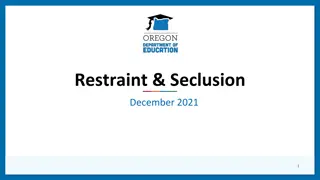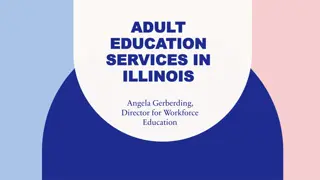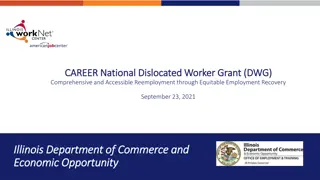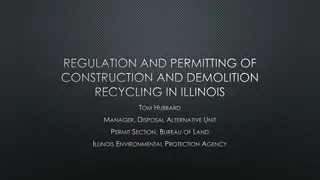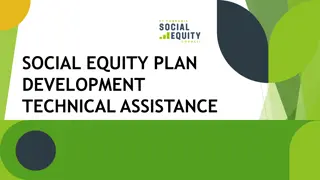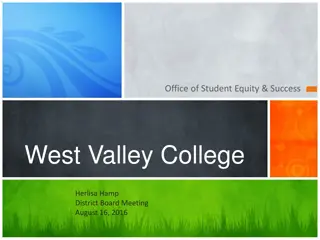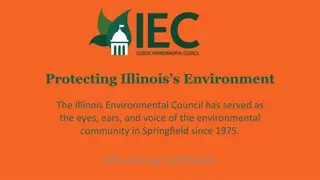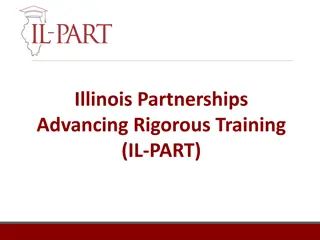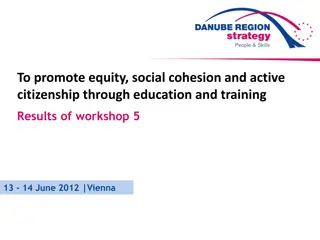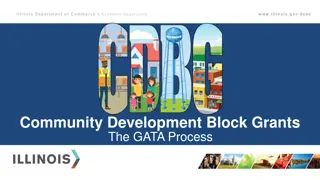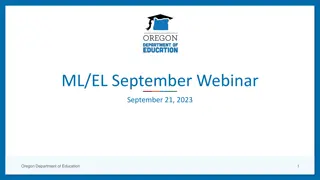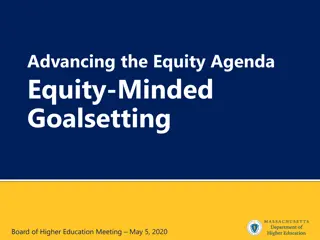Advancing Equity and Economic Development in Illinois Education System
The Illinois Community College Board (ICCB) outlines strategic goals to support students, focusing on equity, workforce development, and seamless transitions. The Board aims to close equity gaps, enhance career pathways, and provide high-quality workforce training opportunities. Emphasis is placed on equitable access, best practices, and continuous improvement to benefit all students across urban, rural, and suburban communities.
Download Presentation

Please find below an Image/Link to download the presentation.
The content on the website is provided AS IS for your information and personal use only. It may not be sold, licensed, or shared on other websites without obtaining consent from the author.If you encounter any issues during the download, it is possible that the publisher has removed the file from their server.
You are allowed to download the files provided on this website for personal or commercial use, subject to the condition that they are used lawfully. All files are the property of their respective owners.
The content on the website is provided AS IS for your information and personal use only. It may not be sold, licensed, or shared on other websites without obtaining consent from the author.
E N D
Presentation Transcript
MID-YEAR BOARD GOALS UPDATE February 2, 2024
ICCB BOARD GOALS GOAL 1: To support all students with a focus on minority, first-generation, and low-income students across urban, rural, and suburban communities, through the promotion of evidence-based best practices that close equity gaps resulting in system-wide improvement of equity metrics across enrollment, retention, advancement, and completion. GOAL 2: To support a seamless transition for students into and through postsecondary education and the workforce by fostering the development of robust career pathways aligned to the needs of business and industry, strong engagement at all levels of the community college system, and with a focus on meeting students where they begin their educational journey, resulting in equitable access and outcomes for all students. GOAL 3: To contribute to economic and workforce development by supporting the Illinois community college system s effort to provide high-quality, dynamic workforce training opportunities that build essential skills for high-value work through apprenticeships, work-based learning opportunities, and competency-based instructional models that result in equitable economic mobility through increased credential attainment. The Board will implement its goals with a focus and commitment to equitable access, opportunities, and outcomes for all students. The Board will promote best practices, enable evidence-based decision-making, and support system-wide continuous improvement.
ICCB GOAL 2: SEAMLESS TRANSITIONTO POSTSECONDARYAND WORK
ICCB GOAL 3: ECONOMICAND WORKFORCE DEVELOPMENT
Illinois Board of Higher Education Presentation to the ICCB February 2, 2024
Postsecondary attainment has increased but geographic disparities persist 2019 2013 Associate or Higher 2022 Associate or Higher or Higher Associate s State Average: 45% State Count: 3,935,431 Total State Population 25+: 8,746,416 State Average: 39% State Count: 3,308,365 Total State Population 25+: 8.509,739 State Average: 43% State Count: 3,710,558 Total State Population 25+: 8,686,299 Source: 2019 American Community Survey 5-Year Estimates See all interactive Equity Maps 1 0 Source: 2022 American Community Survey 5-Year Estimates
Rural adults less likely to have bachelors degree 1 1 Source: 2022 American Community Survey 5-Year Estimates
Disparities in Postsecondary Attainment 1 2 Source: 2022 American Community Survey 5-Year Estimates
Equity Gaps Facing African American Students 2021 GRADUATION RATES ENROLLMENT CHANGE OVER TIME Enrollment has decreased by 37% for African Americans. 70.2% 40.2% 37.3% 15.4% 2013 107k students enrolled Public Universities Community Colleges 2021 67k students enrolled 43.8% 69.8% 43.6% 19.4% African American White Non-Profit Institutions For Profit Institutions 1 3
Equity Gaps Facing Latinx Students ENROLLMENT CHANGE OVER TIME Enrollment has increased by 3% for Latino students. 2021 GRADUATION RATES 70.2% 53.1% 40.2% 27.0% 2013 118k students enrolled 2021 Public Universities Community Colleges 122k students enrolled 43.8% 58.7% 69.8% 40.8% Latino White Non-Profit Institutions For Profit Institutions 14
Equity Gaps Facing Low-Income Students ENROLLMENT CHANGE OVER TIME 2021 GRADUATION RATES Enrollment has decreased by 36% for low-income students 73.2% 50.4% 36.6% 28.4% 2013 280k students enrolled Public Universities Community Colleges 2021 180k students enrolled 56.8% 54.3% 74.5% 29.0% Pell Non-Pell Non-Profit Institutions For Profit Institutions 15
College enrollment gaps by race/ethnicity persist for high school graduates 100% 82.8% 82.0% 80.4% 80% 65.4% 69.1% 64.1% 56.6% 65.5% 59.2% 60% 58.4% 49.5% 48.3% 50.3% 40% 44.7% 43.3% 20% 0% 2019 2020 2021 Asian White Two or More Races Latino African American 16 Source: Illinois State Board of Education
College-going gaps persist for low-income high school graduates 100% 100% Total: 68.8% 80% 80% 73.1% 69.2% 68.8% Total: 44.4% 60% 60% 22.0% 50.2% 40% 40% 44.4% 43.0% 19.3% 46.8% 20% 20% 25.0% 0% 0% 2019 2020 2021 Low-Income Not Low-Income Low-Income Not Low-income Four-Year Two-Year 17 Source: Illinois State Board of Education
Retention and advancement gaps persist for African American students Retention and Advancement of New IL CC Transfer Full-Time Students at Illinois Public Universities 100% Retention and Advancement of New First-Time Full-Time Students at all Illinois Public Universities 100% 87.8% 87.0% 86.7% 85.4% 86.6% 85.7% 85.4% 83.8% 79.3% 78.5% 79.6% 76.8% 80% 80% 73.2% 70.0% 69.5% 64.9% 73.2% 72.9% 70.4% 71.3% 69.8% 60% 60% 66.0% 65.4% 61.7% 60.4% 58.7% 55.8% 52.5% 40% 40% 33.9% 32.2% 27.8% 20% 20% 23.7% 0% 0% 2018-2019 2019-2020 2020-2021 2021-2022 2018-2019 2019-2020 2020-2021 2021-2022 IL Public U. Retention AA IL Public U. Advancement AA IL Public U. Retention White IL Public U. Advancement White IL Public U. Retention AA IL Public U. Retention White IL Public U. Advancement AA IL Public U. Advancement White 18 Source: IBHE IHEIS Fall 2018-19 to Fall 2021-22 Enrollment Collections New Transfer Full-Time Students from Fall of AY2018-19, Fall of AY2019-20, Fall of AY2020-21 tracked to the next Fall.
Retention and advancement gaps persist for Latino students Retention and Advancement of New IL CC Full-Time Transfer Students at Illinois Public Universities 100% Retention and Advancement of New Full-Time Freshmen Illinois Public Universities 100% 87.8% 87.0% 86.7% 86.6% 85.4% 85.7% 85.4% 83.8% 87.7% 72.9% 85.1% 69.8% 76.8% 80% 85.0% 80% 75.9% 75.7% 84.3% 80.8% 70.4% 73.2% 71.3% 69.2% 70.0% 68.8% 69.5% 68.3% 60% 65.3% 60% 64.9% 57.0% 52.9% 51.2% 48.8% 40% 40% 20% 20% 0% 0% 2018-2019 2019-2020 2020-2021 2021-2022 2018-2019 2019-2020 2020-2021 2021-2022 IL Public U. Retention Latino IL Public U. Retention White IL Public U. Retention Latino IL Public U. Advancement Latino IL Public U. Retention White IL Public U. Advancement White IL Public U. Advancement Latino IL Public U. Advancement White 19 Source: IBHE IHEIS Fall 2018-19 to Fall 2022-23 Enrollment Collections First-Time Full-Time Students from Fall of AY2018-19, Fall of AY2019-20, Fall of AY2020-21 tracked to the next Fall.
Retention and advancement gaps also persist for low-income students Retention and Advancement of New First-Time Full-Time Students By Pell Status at All Illinois Public Universities Retention and Advancement of New IL CC Transfer Full-Time Students By Pell Status at All Illinois Public Universities 100% 100% 88.1% 87.0% 86.8% 86.8% 86.2% 85.9% 85.8% 85.7% 80.2% 86.1% 84.6% 80% 84.1% 80% 83.9% 75.1% 75.4% 72.0% 71.5% 73.3% 73.4% 70.8% 72.7% 71.2% 71.1% 68.8% 68.7% 66.6% 67.0% 60% 60% 64.9% 52.7% 48.7% 46.5% 40% 40% 42.7% 20% 20% 0% 0% 2018-2019 2019-2020 2020-2021 2021-2022 2018-2019 2019-2020 2020-2021 2021-2022 IL Public U. Retention Non-Pell IL Public U. Retention Pell IL Public U. Retention Non-Pell IL Public U. Retention Pell IL Public U. Advancement Non-Pell IL Public U. Advancement Pell IL Public U. Advancement Non-Pell IL Public U. Advancement Pell 20 Source: IBHE IHEIS Fall 2018-19 to Fall 2022-23 Enrollment Collections New FT transfer Students from Fall of AY2018-19, Fall of AY2019-20, Fall of AY2020-21, Fall of AY2021-22 tracked to the next Fall. For discussion purposes only
Over 1.7 million adults have some college but no degree Some College, No Degree in Illinois by Race/Ethnicity 1,400,000 30.0% 28.1% 1,159,865 1,200,000 23.8% 25.0% 1,000,000 20.0% 20.5% 800,000 16.8% 15.0% 600,000 10.0% 11.2% 400,000 323,389 207,682 5.0% 200,000 68,281 7,488 0 0.0% White African American Latino Asian Other Within Race/Ethnicity Category % 21 Source: 2020 American Community Survey 5-Year Estimates
Equity Strategy 1: Support student learning renewal, social-emotional, and basic needs Grants, Collaboration, and Communities of Practice Benefits Navigators HOUSE Liaisons Illinois Campus Cares Mental Health Services and Illinois Campus Cares Technical Assistance Center 22
Equity Strategy 2: Establish and implement institution-level equity plans and practices to close gaps Enacted in P.A. 102-1046, June 7, 2022. Required of all public institutions of higher education. Encouraged for private institutions. Equity Plans and Practices to close gaps in enrollment, retention, completion, and student loan repayment rates. Focus on Black, Latinx, AAPI, Native American, rural, adult, women, & people with disabilities. IBHE, with ICCB, to establish guidelines, provide support, study, report effectiveness and outcomes . annually to the General Assembly/Governor. Framework released to institutions Nov. 9, 2023 First baseline plan due May 31, 2024 23 23
Equity Strategy 4: Attract and support working adults Short-term workforce training at community colleges in high-need communities for specific sectors with workforce gaps. Jobs/career pathways that lead to 30% above the average living wage. https://www.illinoiswei.org/ 60%must be African American Over 120 programs at 18 community colleges enrolling 73% African American students. 24
Equity Strategy 5: Consider implementation of Direct Admissions Public University Uniform Admission Pilot Program (110 ILCS 118/1) NIU, SIU, EIU, AND WIU provide automatic general admission for students in top 10% of class Students must complete minimum college preparatory coursework Students must apply using regular admissions process Expanded in 2023 to include community college transfer students beginning in AY 2024-2025 Pilot began in AY 2022-2023 at U of I. Transfer students guaranteed admission at these universities if: Enrolled in an Illinois community college after graduating from state high school; Earned a minimum of 36 graded, transferable hours; Attained 3.0 GPA on all transferable coursework; and Satisfied the universities English language proficiency requirement. Universities may implement less restrictive criteria than outlined in the law. 25
Equity Strategy 6: Expand equitable access, support, and success in early college Impact of Dual Credit Nearly doubles the graduation rate at community colleges, compared to high school students who did not take dual credit. Demographic data suggest similar results. All 48 community colleges offer dual credit with over 13,000 dual credit courses to 75,000 students in academic year 2021. Represents one in six students enrolled in community college courses annually. $3.0M grant program for Community Colleges focused on: Planning and implementation of strategies with the explicit purpose of supporting student persistence to college completion. Supporting or improving equitable access to dual credit, focused particularly on students who have been historically underrepresented. Proposals Received: January 26, 2024 26
Equity Strategy 7: Provide technical assistance to support developmental education reform Updating the Multiple Measures Placement Policy. Updated ICCB Administrative Rules to meet Developmental Education Reform Act (DERA) Requirements. Evidence-Based Models. Co-Requisite Remediation Implementation Toolkit February 2023 comprehensive report on development education reform efforts More students placed in corequisite models: majority of math placements and overwhelming majority of English Language Arts placements 27
Sustainability Strategy 2: Invest an additional $50M each year to reach $1 billion in MAP funding over 10 years Sustainability Strategy 3: Allow MAP to be used for year-round study In FY02, the maximum MAP Award covered 100% of Public University tuition and fees. The unprecedented $222 million increase in FY23 and FY 24 increased coverage to 50% at public universities and 61% at community colleges $18,000 $16,000 $14,000 Not Covered by MAP $12,000 Not Covered by MAP $10,000 $8,000 $6,000 44% Covered by MAP $4,000 100% 100% 39% 50% Covered by MAP 39% $2,000 $0 29 02 03 04 05 06 07 08 09 10 11 12 13 14 15 16 17 18 19 20 21 22 23 24 Fiscal Year
Sustainability Strategy 4: Build programs to address challenges of holds on student accounts Student Debt Assistance Act (110 ILCS 66/1 ) prohibits withholding transcript even if student owes a debt Covers all public universities and community colleges, Private Business and Vocational Schools, and any postsecondary education offered online to someone in Illinois Institution to develop policies for financial or physical hardship withdrawal and how to obtain transcript that has been withheld because of debt Debt sent to collection agency cannot be reported to a credit reporting agency Notice and process for students to file a complaint with the Attorney General s Office Starting July 1, 2024 institutions report annually IBHE or ICCB Institutions implement innovative programs to help students with outstanding balances return to school Chicago State University Cougar Return City Colleges of Chicago Fresh Start 30
Growth Strategy 3: Align the states economic development and higher ed strategies, ensuring both address historic inequities Non-credit workforce training grant for community colleges to: Engage with employers Develop curriculum and deliver non-credit customized training to prepare individuals with specific technical skills Partner with employers to conduct skill assessment of employees. Deliver essential employability skill development workshops for employees to ensure individuals are successful in the workplace. Conduct professional development training for employees for staff development, retention, and improved workplace culture. Provide other business solutions to increase efficiency and competitiveness. Provide supports to students through coordination with workforce partners New Non-Credit Workforce Training Grant Customized training and business solutions Community colleges have a long background in providing customized training and specialized business solution services to local employers. Increases innovation and economic development, helping companies upskill their incumbent workforce. 32
Growth Strategy 5: Establish a consortium of public universities and community colleges to better serve the incumbent early childhood workforce Streamline degree completion for workforce Students can take coursework at multiple consortium institutions Community colleges degrees transfer in their entirety Navigators provide personalized assistance for application and financial aid and connection to Coach Coaches and Mentors support students to persist and complete their studies Scholarships for students and funding for institutions Enrollment increased 22% from 4,825 to 5,887 Embodied in 110 ILCS 28/ www.ecace.org 33
Strategy 6: Expand models of teaching and learning to align with work of the future; Strategy 7: Enhance access to educator preparation programs; Strategy 8: Strengthen statewide transfer system ICCB Dedicated staff with a focus on teacher education Exploring alternative teacher education models. Convening Teacher Education Panels in the Illinois Articulation Initiative Implementation of Senate Bill 2288 Major Acceptance Legislation Exploring technological innovations Examining Direct Admissions Processes Convening Transfer Working Group through the Higher Education Futures Table ICCB Proposed legislation to waive transfer application fees www.itransfer.org 34
Next Steps outlined in A Thriving Illinois Immediate next steps from A Thriving Illinois: Develop an Accountability System Launch Development of Institutional Equity Plans Convene a Business and Employer Advisory Council to IBHE Develop a Public University Funding System Reinforce Learning Renewal and Social Emotional Supports Re-Engage Adults Respond to Early Childhood Educator Shortage Enhance Transfer Infrastructure Develop Full Implementation Plan = Work with comprehensive approach has begun 35
Where do we go from here? We have on-going implementation work for what has already launched We identified Strategies where we need to expand efforts or dig deeper We have Strategies not yet launched At the conclusion of A Thriving Illinois report, we identified immediate next steps Question for Board consideration: What do you see as the priorities for the next three years? 36
25 Strategies for a Thriving Illinois 1. Support learning renewal and student social emotional and basic needs 2. Implement institution-level equity plans and practices 3. Use equitable talent management to increase and retain faculty, staff and trustees of color 4. Provide more pathways through higher education for adults 5. Consider a direct admissions program to simplify college search and admissions 6. Expand equitable access to early college coursework for high school students 7. Support implementation of developmental education reform 8. Expand college access and support models to improve college-going and completion 38
25 Strategies for a Thriving Illinois 1. Invest Invest in public higher education through an equitable, stable, and sufficient funding system 2. Increase Monetary Award Program (MAP) funding to $1 billion over ten years 3. Allow MAP grants to be used for year-round study 4. Address the challenge of holds on student accounts that prevent them from completing their degrees 5. Support new low-interest loan programs through the Office of the Treasurer for low-income students 6. Encourage creative options for family savings through Illinois 529 plans 7. Pilot and expand shared services programs to reduce administrative costs 8. Expand joint purchasing among institutions 39
25 Strategies for a Thriving Illinois 1. Leverage the Illinois Innovation Network 2. Establish a statewide Business and Employer Advisory Council to foster the growth of Illinois talent pipeline 3. Align the state s economic development and higher education strategies, ensuring that both address historic inequities 4. Encourage high school graduates to stay in-state for college and keep talent in Illinois 5. Establish a consortium of community colleges and universities to better serve the incumbent early childhood workforce 6. Expand higher education models of teaching and learning to prepare students for success in the work of the future 7. Enhance access to teacher preparation programs 8. Strengthen the credit transfer system to help students stay on track 9. Consider the role the Private Business and Vocational sector for workforce needs 40



